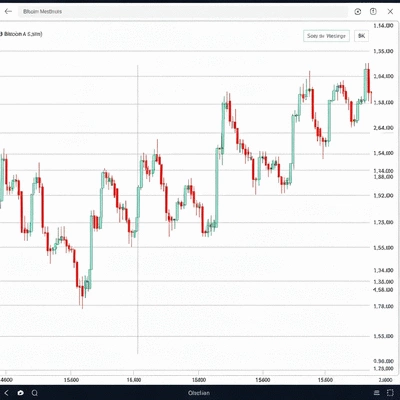External Influences
- • News & Media: Positive or negative press.
- • Regulatory Changes: New laws or government actions.
- • Global Indicators: Economic stability/instability.
Have you considered how much market sentiment influences Bitcoin's price? Understanding these dynamics can significantly enhance your trading strategy and risk management. Here’s what you will learn from the article!
Understanding the primary causes behind Bitcoin's significant price swings is crucial for investors. These factors often interact, creating a volatile market environment.
Have you ever felt dizzy watching Bitcoin's price jump up and down? Bitcoin's volatility isn’t just a minor detail; it’s a fundamental characteristic that can significantly impact traders and investors alike. Understanding what causes these dramatic fluctuations is key to navigating the crypto market effectively. Let’s break this down!
Bitcoin's price can swing wildly for various reasons. Some of the most common factors include:
As an analyst, I’ve seen how a single tweet can send Bitcoin prices tumbling. Staying informed about these triggers can help you make better investment decisions and mitigate risks.
Market sentiment plays a crucial role in Bitcoin pricing. When traders feel confident, prices generally rise. Conversely, fear can lead to rapid sell-offs. Factors contributing to market sentiment include:
Understanding how sentiment affects Bitcoin’s price can give you a significant edge. As I often stress at CryptoMarketCrash Insights, being aware of the emotional aspects of investing is just as important as the technical side. For a deeper dive into how market manipulation can be a factor, Chainalysis offers insights into crypto crime and market integrity.
Trading volume is another key indicator of Bitcoin's price behavior. High trading volumes typically signal strong investor interest, which can lead to price increases. However, market manipulation can distort these signals. Here’s what to consider:
By being aware of these factors, you can better assess potential price movements. Remember, understanding the mechanics behind price fluctuations empowers you to approach the market with confidence! Additional information on the broader crypto market and its regulatory landscape, including Bitcoin, can be found through resources like the Council on Foreign Relations.
As you navigate Bitcoin's price volatility, always remember to set stop-loss orders. This tool automatically sells your Bitcoin at a predetermined price, helping you limit potential losses during sudden market drops. It’s a practical strategy that can safeguard your investments and reduce emotional decision-making during turbulent times.
Bitcoin's price is influenced by external factors like news and media reports, regulatory changes, and global economic indicators. Internally, market dynamics such as trading volume, liquidity issues, and futures trading also play a significant role. Additionally, market sentiment, often swayed by social media and investor behavior, contributes to price swings, alongside manipulative practices like wash trading and pump-and-dump schemes.
Market sentiment significantly impacts Bitcoin's price by driving collective investor behavior. Positive sentiment (confidence) generally leads to price increases, while negative sentiment (fear) can trigger rapid sell-offs. Social media trends, news, and overall economic stability heavily influence this sentiment.
Trading volume indicates investor interest and market activity. High trading volumes often suggest strong interest, which can contribute to price increases. However, trading volume can be distorted by market manipulation tactics like wash trading, which creates a false impression of high demand.
Common market manipulation tactics include wash trading, where traders buy and sell assets to create a misleading impression of high trading volume, and pump-and-dump schemes, where groups artificially inflate a coin's price before selling off, leaving other investors with losses.
Historical Bitcoin price drops teach investors that market reactions are often emotional, emphasizing the risks of panic selling. They highlight the importance of diversification, the impact of external economic factors, and the necessity of continuous education to make informed decisions and prepare for future market uncertainties.
Bitcoin futures allow traders to speculate on future prices without owning the asset. While they can increase market liquidity and offer hedging opportunities, they also amplify speculative trading, which can lead to more significant price movements and increased volatility in both upward and downward trends.
As we reflect on the turbulent history of Bitcoin, it becomes clear that understanding past price drops is crucial for navigating future market fluctuations. Here’s what we learned from these significant events that can help us make informed decisions moving forward:
At CryptoMarketCrash Insights, I’ve seen firsthand how these lessons resonate with both new and seasoned investors. The ability to recognize emotional responses and external influences can mean the difference between a successful recovery strategy and a missed opportunity!
Each major Bitcoin price drop carries insights that inform our approach to investing. For instance, during the COVID-19 pandemic crash of 2020, we noted that:
These insights remind us that while the market may be unpredictable, awareness and preparedness can help us navigate the storm!
As we gaze into the future of Bitcoin, it’s essential to consider how the lessons learned from past drops will shape our strategies. Here are some implications for investors:
By integrating these lessons into our investment approach, we can better prepare for the uncertainties ahead!
Bitcoin futures have emerged as a vital tool in the cryptocurrency market, allowing traders to speculate on Bitcoin's future price without owning the underlying asset. This has important implications for price volatility:
As someone deeply involved in the crypto market, I recognize that understanding the mechanics behind Bitcoin futures can equip us with the tools to navigate price volatility more effectively. It’s all about creating strategies that embrace both opportunity and risk!
Here is a quick recap of the important points discussed in the article:
At CryptoMarketCrash Insights, we're your essential guide through the volatile crypto landscape. We provide real-time news, expert analysis, and recovery strategies for Bitcoin and altcoin drops, empowering you to navigate market crashes effectively.
Navigating Crypto Volatility Together


